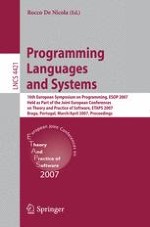2007 | Buch
Programming Languages and Systems
16th European Symposium on Programming, ESOP 2007, Held as Part of the Joint European Conferences on Theory and Practics of Software, ETAPS 2007, Braga, Portugal, March 24 - April 1, 2007. Proceedings
herausgegeben von: Rocco De Nicola
Verlag: Springer Berlin Heidelberg
Buchreihe : Lecture Notes in Computer Science
